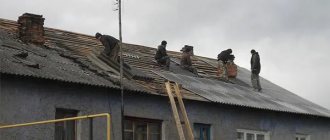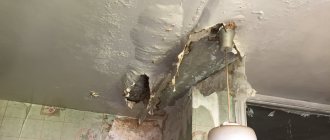Drawing up a defect sheet.
When making repairs to premises, unaccounted for work very often occurs, therefore, the correct and complete preparation of the defective list depends on the high-quality preparation of estimates in accordance with which payment for repair work will be made. To draw up a defective statement, a commission consisting of at least 3 people is appointed. Usually the first representative is the head of the structural unit that operates the premises, the second is the manager of the facility, and the third is a construction and repair specialist. It is necessary that the people appointed to the commission be specialists in the field in which the repair is being carried out, for example, if the repair involves a large volume of replacement of electrical wiring, cables, lamps, then, if possible, the commission should also include an energy engineer if there is a large volume of heating and water supply pipelines , then a specialist knowledgeable in this area, etc. Initially we draw up a draft. First dismantling. Then general construction repair work (from bottom to top in order - floor, walls, ceiling), then electrical installation work, low-voltage networks, plumbing work and other work. The statement takes into account only the volume of work performed, but to check the correctness of the preparation, we give it to an estimator or builder who understands estimates. The estimator asks a million questions. For example: what are the sizes of windows and doors, the width and length of window sills, dismantling windows in a stone building or in a wooden one, names of radiators to be installed, painting in two or one time, installing baseboards with or without a cable channel, or maybe wooden, etc. and so on. The value of the cost of the work performed when drawing up the estimate depends on all this. We supplement the statement taking into account clarifications and adjustments. The statement is approved by the head or chief engineer of the organization that owns the premises.
Source
Possible costs
The documents described above seem to reflect all aspects of the repair and take into account all the nuances. But you should understand that in general, in addition to the purchase of materials and payment for contract services, additional costs are possible, such as:
- ordering a project and plan;
- payment for accountant services (when preparing estimates);
- additional costs in case of unforeseen circumstances.
As it turned out, it is not so difficult to understand the documentation during routine repairs. But if you are doing repairs yourself, relying only on your own is not always the right and profitable solution - feel free to seek help from specialists who know their business.
Didn't find the answer to your question? Find out how to solve exactly your problem - call right now:
+7 (Moscow) +7 (St. Petersburg)
Defective statement: procedure for compilation and sample
A defective statement is a document that is drawn up by an organization to identify faults in a fixed asset item for the purpose of repairing it. The form must be fixed in the accounting policy.
The work of the organization is related to the preparation of documentation for all cases. Almost every step must be recorded for internal accounting and to confirm the transaction at the request of external auditors. Maintenance of fixed assets is an operation that requires special care to document. If an expensive property breaks down, it cannot simply be repaired; it is necessary to identify the fault, establish the cost and possibility of repair. Only after such actions can the cost of repairs be attributed to expenses that reduce profit. To do this, a defective statement is drawn up, which is approved by the manager, and signed by authorized persons (letter of the Ministry of Finance No. 03-03-06/4/94 dated 12/04/2008).
Why is troubleshooting needed?
In accounting
Based on the defect, the need and estimated cost of repairs are confirmed for accounting and tax purposes. At first glance, it seems that this is unnecessary bureaucracy, but in practice, the absence of a defective statement during a tax audit will lead to suspicion of inflating expenses and obtaining unjustified tax benefits. In addition, tax officials check the reality of the costs of repair work by comparing the cost reports submitted to them with other primary and accounting documents.
Based on defects, as tax authorities claim and the courts confirm, it is prohibited to confirm the need for reconstruction or modernization. It contains information about identified breakdowns and malfunctions, and not about the condition of the object and its wear and tear. Therefore, there is no sample defective statement for the reconstruction of premises; it is compiled only for major repairs. If a defect is drawn up, the tax authorities will recognize it as unfounded, and tax savings based on it as unlawful. Judicial practice confirms this (resolution of the Arbitration Court ZSO No. F04-21029/2015 dated 07/09/2015 in case No. A81-4014/2014).
ConsultantPlus experts looked at how to fill out a “defect” in different situations. For example, for the repair of fixed assets or a car. Use these instructions for free.
In procurement
When preparing tender documentation and estimates for major repairs, defect detection is required. It is included in the estimate to justify the materials included. The document indicates all damage and the scope of work to correct them. Based on the defects, they draw up technical specifications for workers, estimates and calculations. This is what a fault finding for repair work looks like:
Drawing up an application
Contacting the company
Let's take a closer look at how to correctly draw up an application for roof repairs.
- Like any other document, this application begins with the information of the applicant and addressee. In the upper right corner in the “To” column we write the last name, first name and patronymic of the director or head of the public utility service, as well as the name and legal address of this organization.
- Next, in the “from whom” field, enter your data and address.
Useful: it is also worth indicating in the application a cell or landline phone number, by which employees of the utility organization can promptly contact the applicant if necessary.
- Stepping a little lower, in the center we write the name of this document - “Statement”. In this case, an application for repairs is submitted, so the document is precisely an application, and not a claim or complaint.
- You can immediately enter the date of drawing up the application at the bottom of the sheet and sign with a transcript (indicating your last name).
- The following is the reason for contacting the organization. The first step is to write that you are the owner of the apartment in which there was a water leak from the roof, and also indicate the title document, a photocopy of which can be attached to the application.
- Next, the actual situation is described: the date and approximate time of the leak occurrence, the room are indicated, in addition, the nature of the leak should be described: where the water comes from, how it flows along the walls and ceiling, how strong, etc.;
- The following describes the material damage caused: what property is damaged, what kind of repair of a room or an entire apartment is required in this case.
Important: the management company must have samples of all documents required for repairs, such as a defect sheet and an estimate for roof repairs, which should be reviewed in advance.
Photograph of the damage
In case you need to conduct an independent examination or file a lawsuit, it is recommended to photograph all areas of leaks and the damage caused by them. These photographs may also be attached to the application.
The application ends with a request to draw up a defect report for roof repairs, eliminate leaks and compensate for damage caused. It looks something like this:
“Based on the above, guided by Articles No. 36 and No. 162 of the Housing Code of the Russian Federation, Article No. 4 of the Federal Law “On the Protection of Consumer Rights,” paragraph B of Article No. 40 of the “Rules for the Maintenance of Property in a Residential Apartment Building,” as well as Appendix No. 2 of the “Rules and Norms technical operation of the housing stock,” please...”
Important: when presenting requests, it is recommended to formulate them clearly and clearly and assign them serial numbers.
You should definitely use references to regulations and laws, showing that you know your rights and are going to defend them.
The following is a list of documents attached to the application.
The application is written in two copies:
- The first is given to the dispatcher;
- On the second, the dispatcher signs for receipt, and we keep it.
Important: if the dispatcher refuses to accept the application or sign for receipt, two witnesses should be involved and this fact should be recorded with their signatures.
Defective statement
- Defect sheet - compiled to determine the volume of restoration or major repairs of buildings.
We will consider cases of compiling such a statement in relation to the technical inspection of buildings and structures.
Defect sheet sample
The defective statement is a justification for the estimated construction costs. Serves as the main document in justifying estimated costs because it was compiled by an expert organization in accordance with SNiP, GOST, ROST. A defective list or a summary table of repairs with a definition of the volume and name of the defect (for restoration repairs) according to the estimated classification gives the Customer undeniable advantages in justifying costs, as well as including additional volumes in the estimates. Special situations may arise when it is necessary to justify expenses of an uncertain nature. In particular, in cases of detection of hidden defects in structural elements such as destruction of foundations, corrosion of concrete and metals identified during the inspection of building structures and detected in a non-visual field (hidden). Such defects require an increase in the estimated cost (that is, beyond what was planned by the budget) and immediate elimination using an emergency scheme.
Defective statement form
It is advisable to draw up such a statement before any repairs or forensic construction and technical examination. All structures and buildings undergo a scheduled engineering and technical inspection (once every 5-10 years) to ensure their safe operation. Buildings subject to reconstruction, major and current repairs must, before starting work, undergo a procedure for drawing up a defective list, the main purpose of which is to justify the relevance of the repair based on confirmed volumes.
Defect sheet sample construction
Cost calculator for development, verification and non-state examination of estimates for the state budget
| Development of defective list and volume list. Development, technical report (visual technical inspection), photographic recording of the object, estimate. Checking estimates. Calculation of the cost of non-state examination of estimates. | ||
| simple | for examination | |
| Calculation and explanatory note for the estimate, list of defects, list of quantities of work | 0 | 0 |
| Drawing up a list of defects, a list of quantities of work | 0 | 0 |
| 1. Columns, pilasters | 0 | 0 |
| 2. Walls | 0 | 0 |
| 3. Partitions | 0 | 0 |
| 4. Load-bearing elements of the coating | 0 | 0 |
| 5. Foundation | 0 | 0 |
| 6. Roof | 0 | 0 |
| 7. Floors | 0 | 0 |
| 8. Power supply system | 0 | 0 |
| 9. Water supply system | 0 | 0 |
| 10. Drainage system | 0 | 0 |
| 11. Heating, ventilation and air conditioning, heating networks | 0 | 0 |
| 12. Communication networks | 0 | 0 |
| 13. Gas supply | 0 | 0 |
| 14. Drawing up estimates for design and survey work | 0 | 0 |
| 15. Drawing up estimates for repair and restoration work, reconstruction. | 0 | 0 |
| 16. Drawing up estimates for new construction. | 0 | 0 |
| 17. Checking estimates | 0 | 0 |
| 18. Non-state examination of estimates with the issuance of an opinion for the state budget | 0 | 0 |
Preparatory stage
If the front door of an apartment building is in poor condition, sooner or later the residents are faced with the task of carrying out restoration work. Not everyone knows where to start or what steps to take. Cosmetic repairs in accordance with current legislation are carried out at least once every five years, and the management company can appeal the deadlines. But what to do if, say, the repair was carried out poorly, and although the time for the next one has not yet come, the paint on the walls has peeled off, the plaster is falling off the ceiling, and the steps are crumbling?
Caring people decide to carry out repairs themselves. Moreover, if the house is managed by a homeowners association, where all problematic issues are studied together. After all, users of actually joint home ownership are obliged to participate in the improvement of the building and surrounding area at their own expense.
As a result of an external inspection and a thorough study of problem areas, a defect report is drawn up - a document recording deficiencies, malfunctions and breakdowns. It is drawn up based on the commission’s findings.
List of requirements:
- repair of the vestibule and access doors;
- restoration of the visor;
- replacement of glass and frames;
- painting walls;
- whitewashing (painting) of the ceiling;
- updating communication systems;
- partial repair of stair railings;
- replacement of correspondence boxes;
- electrical door repair;
- restoration and painting of the garbage chute;
- replacement of wiring (laying in boxes);
- bringing lamps into proper condition.
A defective list is compiled based on real needs (something is excluded from the list, something is added), and it is signed for further use. Often, contractors who will carry out the work are invited as experts to ensure that the document is drawn up and signed correctly.






